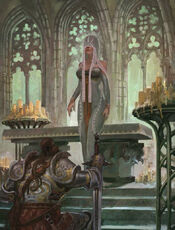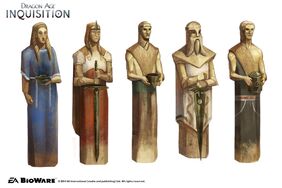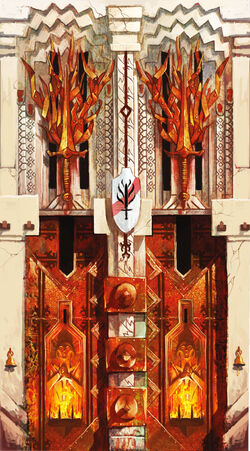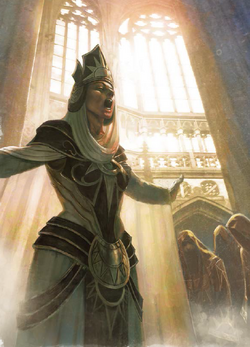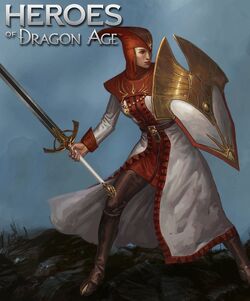- For the Chantry headquartered out of the Argent Spire in Minrathous, see Imperial Chantry.
The Orlesian Chantry is the dominant religious organization in Thedas. It is based on the Chant of Light, a series of teachings written by Andraste, the prophet of the Maker, and her disciples. It was founded by Kordillus Drakon, the first emperor of Orlais. The Chantry is a denomination of Andrastianism; its followers are known as Andrastians.
The Chantry's goal is to spread the Chant of Light to all four corners of the world and to all races. The view of the Chantry on non-humans is that they need saving—they have turned even further from the Maker's grace than humanity has—a view that has led much of humanity to look down on them. There are no known Andrastian Qunari. The elves worshipped, and in some cases still worship, the Elven pantheon, and dwarves venerate the Stone. Once all peoples have accepted the Chant and practice its teachings, the Maker will return and restore the world to its former glory. As such, Andrastian religion in Thedas can be described as deistic in that the Maker abandoned the world, and he will not heed prayer or perform any other function until his favor is regained.
The Orlesian Chantry calendar is used everywhere in Thedas, save for the Tevinter Imperium, and is the source of the names of the Ages.
History[]
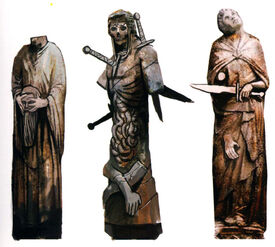
The Chantry originated as one of the many cults emerging upon the legend of Andraste’s martyrdom.[2] Known as the Cult of the Maker, it was without central leadership[3] and its followers were oppressed.[4] The clerics had to hide their lore from Tevinter magisters by way of ciphers and encoded scrolls.[5] In -130 Ancient, cult practitioners organized Andraste's teachings into hymns, creating the Chant of Light, leading to their spread in popularity.[6]
There were various cults of the Maker until Kordillus Drakon, who would become the first emperor of Orlais, unified them by the sword and formalized them into the Chantry in -3 Ancient.[7] Drakon established Andrastianism as the national religion. The first Divine, Justinia I, was declared four years later. Though her appointment caused significant frustration in Tevinter, which had been organizing Andrastianism on their own for over a century, they initially attempted to appease the newly created Orlesian Chantry by transferring authority over the faith from the Archon to the grand clerics.
Drakon's military successes during the Second Blight significantly expanded the borders of Orlais, and soon after, the conquered lands converted to the faith. While these lands would later liberate themselves from Orlesian rule following Drakon's death, Andrastianism remained.
The Nevarran Accord signed in 1:20 Divine brought the Inquisition and the newly created Circles of Magi under the Chantry's authority. The Inquisition divided into two new orders: the Templar Order, charged with looking over the Circle and hunting apostates and maleficars, and the Seekers of Truth, overseers of the templars and special agents of the Divine.
By 1:45 Divine, the teachings of Andraste had been popularized in Antiva.[8] The Antivan Crows started as an arm of the Chantry. In the hills north of Treviso, an order of monks used the herbs grown in the gardens of their abbey to oppose the rule of a despotic duke in the only manner the monks could.[9]
Tensions between the Tevinter and Orlesian Chantries came to a head during the Towers Age over disagreements on the meaning of the commandment that "magic exists to serve man, and never to rule over him." In Tevinter, where magic had long been a valued trait, prized and nurtured through selective breeding in the upper classes,[10] the clerics preached that magic must serve the greater good and not be used to control the minds of others, which they believed was best accomplished by allowing mages to take part in government. When the Orlesian Chantry finally learned of this in 3:87 Towers, Divine Joyous II demanded they revert to the Orlesian version of the Chant. Tevinter refused, claiming corruption within Val Royeaux. Divine Joyous II declared them all heretics, leading the Archon to appoint Grand Cleric Valhail, a man and a mage of the Circle, to the position of Imperial Divine.[11][12]
With so much influence over the people, the Chantry can exert considerable political pressure on the ruling classes in many areas of concern. In extraordinary times, and in deference to Andraste, the Divine may also be moved to declare an Exalted March. These religious crusades have mobilized armies of thousands to destroy the heretical enemies of the Maker. The first March after Andraste's death was against the elves of the Dales, which led to Divine Renata I's decree to create Alienages as well as to destroy any Chantry art and references to elves, save a single original mural of Shartan with his ears cropped. A faithful copy exists at the University of Orlais.[13] The next five were against Tevinter, and the most recent were against the Qunari, with the support of the Imperial Chantry.
Involvement[]
Dragon Age: Asunder[]
Dragon Age: Inquisition[]
The Chantry has been "the thing keeping the lid on the pot of Thedas."[14] In 9:41, Divine Justinia V organizes peace talks between representatives of both Rebel Mages and templars at the Temple of Sacred Ashes. However, Corypheus has infiltrated the conclave to use Justinia as a ritualistic sacrifice. When the ritual is interrupted, it triggers an explosion that creates a Breach in the sky and kills the Divine and most of the Chantry leadership. With the death of the Divine and the lack of a clear successor, the Chantry succumbs to chaos.[15] What's more, Chancellor Roderick uses his influence to convince the remaining clerics to publicly denounce the reformed Inquisition, calling them heretics for harbouring the sole survivor of the conclave attack, the Inquisitor, who has been labeled the Herald of Andraste. Once the Inquisition was backed by an independent supplier of lyrium, the dwarves of Orzammar, it further incites ire from the remains of the Chantry. The remaining clerics then focused on consolidating the Chantry's power rather than comforting the masses.
The Inquisitor travels to Val Royeaux on the advice of Mother Giselle to address the clerics and give them reason to doubt their denouncement, as the opposition's strength is in their unity. The Chantry is further humiliated when Lord Seeker Lucius Corin refuses to bring the templars back into their fold.
As the Inquisition gains great renown, the Chantry looks to the Inquisition for candidates for the title of Divine, mainly Cassandra Pentaghast and Leliana, co-founders of the Inquisition and former Hands of the Divine, though Vivienne is also considered.
In 9:42 Dragon, Divine Victoria is elected to lead the Chantry and institutes controversial reforms.
Teachings[]
These truths the Maker has revealed to me:
As there is but one world,
One life, one death, there is
But one god, and He is our Maker.
They are sinners, who have given their love
To false gods.
Magic exists to serve man, and never to rule over him.
Foul and corrupt are they
Who have taken His gift
And turned it against His children.
They shall be named Maleficar, accursed ones.
They shall find no rest in this world
Or beyond.
All men are the Work of our Maker's Hands,
From the lowest slaves
To the highest kings.
Those who bring harm
Without provocation to the least of His children
Are hated and accursed by the Maker.
Those who bear false witness
And work to deceive others, know this:
There is but one Truth.
All things are known to our Maker
And He shall judge their lies.
All things in this world are finite.
What one man gains, another has lost.
Those who steal from their brothers and sisters
Do harm to their livelihood and to their peace of mind.
Our Maker sees this with a heavy heart.—From "Transfigurations 1:1-5[16]
The Chantry's faith is rooted in four core principles[17]:
- Magic is a corrupting influence in the world.
- Humankind's sin of pride destroyed the Golden City and created the darkspawn, terrible embodiment of that sin.
- Andraste was the bride of the Maker, a prophet and martyr whose ultimate sacrifice must be remembered and honored.
- Humankind has sinned and must seek penance to earn the Maker's forgiveness. When all people unite to praise the Maker, he will return to the world and make it a paradise.
Until the Maker's return, the faithful believe that the Maker watches, a patient observer rather than an absent god. They do not believe the Maker will perform miracles on their behalf, but he will shed a tear for the suffering of those who do not deserve it. The Chantry's interpretation of Andraste's teachings emphasizes death, guilt, and the difference among races and genders. Elves, dwarves, and qunari are deemed to have strayed further from the Maker, making them unsuitable for the priesthood. The Chantry sees women as the purer sex, while men are all judged by Maferath's betrayal; as such, the Chantry does not allow them to rise to any senior spiritual role.[18]
Symbols[]
The sun represents the fundamental goal of the Chantry: if all lands under the sun raise their voices in the Chant, then the Maker's eye will turn back to his Children.[19]
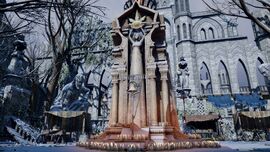
A shrine in Suledin Keep depicting a sun and a stylized Andraste
Fire is a symbol of purity in the Chantry, following the example of Andraste, who was cleansed of her sins as she burned at the stake. Each temple maintains a brazier lit with eternal flame in her memory; the most famous of these is the Holy Brazier at the Grand Cathedral in Val Royeaux. Chantry members may also ritually burn themselves, passing their hand over flame or burning a paper upon which their sins are written. In extreme cases, the faithful may undergo branding or self-immolation.[18]
Chantry hierarchy[]
- See also: Codex entry: Chantry Hierarchy
The actual priesthood of the Chantry is made up entirely of human women, as official Chantry doctrine stating that elves and dwarves are further from the Maker than humanity, and the Chant holding that men are more vulnerable to anger or passion.[20]
At the head of the Chantry is the Divine, who leads from her seat in the Grand Cathedral of Val Royeaux. Below her are the Left and Right Hands of the Divine. These are her personal agents and act as her voice if she is not otherwise present.
According to Cassandra Pentaghast, the position of Right Hand is normally reserved for templars of the Knight-Divine, but exceptions can be made. Cassandra herself started her career as a Seeker of Truth but earned her position as Right Hand by saving the life of Divine Beatrix III. As Cassandra describes it, the role of the Right Hand is to do what hands are capable of: it gives, it takes, it beckons... it makes a fist. While the Right Hand's actions are more public, the Left Hand's actions are generally clandestine. The Left Hand's actions typically involve investigations, political manipulations, and assassinations. According to Leliana, the Left Hand protects the Divine by keeping an eye and ear out for dangerous situations, identifying threats, and dealing with them.[21]
In summary, the Right and Left Hands extends the Divine's reach beyond the Grand Cathedral and go where the Divine could not.[22]
Below them are the Grand Clerics who are the Chantry's highest authority in a country or a region. After a Divine dies, Grand Clerics are required to travel to Val Royeaux for the Grand Consensus, a meeting where Chantry leadership unanimously elect the new leader of the Chantry.
Beneath the Grand Clerics are the mothers, who are responsible for administering to the spiritual well-being of their flock. If a mother is in charge of a local Chantry, she is called a Revered mother.
Beneath mothers are the brothers and sisters, consisting of three main groups: affirmed, initiates, and clerics. Brother is the highest title that men can aspire to have. The initiates take vows and receive an academic education. Those who seek to become templars receive a martial education in addition. Initiates are simply people who vow to dedicate their lives to the Chantry and in doing so, become men and women in training — whether in academic knowledge or the martial skills of a warrior.
Clerics are the scholars of the Chantry, and they are often found in Chantry archives. These sages preside over libraries of books and arcane knowledge. The most senior of these clerics, placed in charge of such archives, receive the title of "elder," which is, however, beneath that of mother.
Brothers and sisters are the rank and file of the Chantry,[23] and initiates not assigned to the clerics or templars act as an invisible army working to maintain the Chantry. Some of their duties include ensuring meals are delivered, repairs are made, managing the lyrium storehouses,[24] and ensuring that the faithful are tended to. The male dominated position of High Chancellor is a brother who controls who is permitted audience with the Divine, handles her correspondence, delivers her word to Thedas, and serves as her advisor on matters which may be mundane but cannot be disregarded. Despite the High Chancellor's relatively low position in the Chantry hierarchy compared to the clergy, he enjoys a considerable amount of influence due to being in the Divine's inner circle.[25]
Some followers become lay brothers/sisters (a.k.a. lay-bretheren), those who live and work in a local Chantry to live a life of religious contemplation, yet are not a part of the priesthood or even an initiate. The Chantry supposedly provides succor and safe harbor to any who seeks it. Lay brothers/sisters are those who become affirmed − i.e., they affirm their belief in the Maker, Andraste, and the Chant of Light. They do not take vows however.[26] Often lay-bretheren are people who have led a difficult or irreligious life and have chosen to go into seclusion, or even orphans and similar unfortunates who were raised into the Chantry life. The affirmed take care of the Chantry and are in turn afforded a life of quiet contemplation, no questions asked.[23]
The role of men in the Chantry[]
Men are only able to become true priests in the Imperial Chantry of the Tevinter Imperium; in the rest of Thedas they are judged by the betrayal of Maferath and found too passionate to lead in matters of spirit. Nevertheless, male members of the Chantry can and do play a vital role in its workings.
Though men are generally assumed to be merely templars, chanters or scholars, they also comprise an "invisible army" that keeps the Chanty fed and in good repair, and also sees to the physical well-being of Andrastian faithful. Furthermore, the male role of High Chancellor is one that works directly alongside the Divine and is in many ways her administrator and public gatekeeper. In this way, the Chantry's male acolytes allow their female counterparts to guide the souls of Thedas while seeing to it that small but vital services are rendered to their material lives.[27]
Practices[]
- See also: Sexuality and marriage and Funerary rites
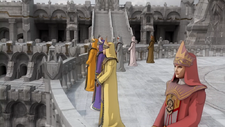
Chantry clergy greet pilgrims during the Ten Year Gathering.
Offertory is part of the Chantry service.[28]
The funeral rites of the Chantry involve cremation. As Andraste's body was burned, and her spirit ascended to stand by the Throne of the Maker, so too will the spirits of her followers. The practice of cremation may also be to ward off the possibility of the corpse becoming the subject of demonic possession.
The pyres of peasants are often small and ringed with stones. Such burnings occur within the settlement, despite the fire risk, rather than at a distance. Criminals may be burned in a mass pyre.[29]
The Chantry hosts a Ten Year Gathering, in which pilgrims journey to the Grand Cathedral in Val Royeaux to pray for peace.[30]
Certain members, called Chanters, speak only in quotations of the Chant of Light. Ostensibly this is to spread the word of the Maker far and wide.[31]
Chantry Sisters take turns singing in the choir tower so that the Chant of Light is heard at all times in all the corners of the world.[32]
Although the clergy, such as a Revered mother, can ask for donations to their local Chantry, the Chantry can also demand tithes on estates in regions where they hold political influence.[33]
As specified by the Nevarran Accord, the Chantry's ranking representative holds authority over the local templars[34] and is also able invoke the Right of Annulment. Typically, the ranking Chantry representative of a country or region is the Grand Cleric. Should a Grand Cleric be incapacitated, authority over the templars would transfer to a de facto successor.
The Chantry strictly control the supply of lyrium in practically most of Thedas; and Orzammar sells all the processed lyrium they don't use themselves to the Chantry. From the Chantry, it is dispensed both to the templars, who make use of it in tracking and fighting maleficarum, and to the Circle.[35]
The faithful who give their lives to the Exalted Marches earn a special place at the side of the Maker as the "Exalted".[18] A still greater honor for service, the defenders of the faith are sometimes given the title of "Anointed". The Anointed are seen as the hands of the Maker and the title is exceptionally rare.[18] Notable Anointeds include:
- Kordillus Drakon I – first Emperor of Orlais and founder of the Chantry[36]
- Hector – one of Andraste's loyal followers and Lord of the fortress of Nevarra from which she was captured after Maferath's betrayal[37]
- Calenhad Theirin – first King of Ferelden[38]
- Clothilde of Crechy – a warrior renowned for defending the innocent[39]
- Mhemet – a Rivaini Templar whose love of killing elves pushed him to many victories during the Exalted March of the Dales[40]
Scholarship[]
All initiates receive an academic education, and notable among them are the clerics. Clerics are the true academics of the Chantry, those men and women who have dedicated themselves to the pursuit of knowledge.[23]
Many of Thedas' most prominent scholars come from within the Chantry's ranks, such as Brother Ferdinand Genitivi and Sister Petrine. The Chantry actively encourages its followers to read books other than the Chant of Light. Chantry-approved writings include Ines Arancia's The Botanical Compendium, Enchanter Mirdromel's Beyond the Veil: Spirits and Demons and Frederic of Serault's A Study of the Southern Draconids.[41]
The Chantry is not above history revisionism and censorship however. After the Exalted March against the Dales, the Canticle of Shartan was removed from the canonical Chant of Light and all Chantry art depicting elves was ordered destroyed (save a single mural depicting Shartan, whose ears were cropped). Many books are banned by the Chantry as well, usually those dealing with magic and other religions. Erotic literature is frequently banned as well.
A partial list of especially banned books[42]:
- The Imperial Chant of Light
- The Qun
- Questioning the Chant, by Magister Vibius Agorian
- Veilfire, a Beginner's Primer with Numerous Teachings, Exercises, and Applications by Magister Pendictus
- An Alchemical Primer of Metallurgy and The Alchemist's Encyclopedia, by Lord Cerastes of Marnas Pell
- The Randy Dowager
- Carmenum di Amatus, an anthology of poetry
The Chantry also recommends caution when dealing with Varric Tethras, former Chantry Sister Laudine, and Elven sources.
Known chantries[]
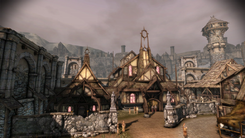
The Denerim cathedral
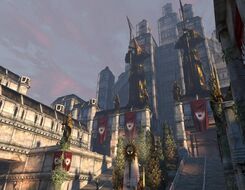
The Kirkwall chantry
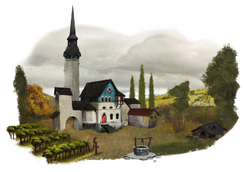
A countryside chapel in Orlais
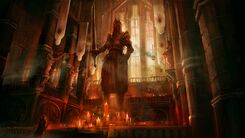
A Chantry altar
- Abandoned Chantry (Forlorn Cove) – the abandoned site can be the scene of bloodshed, depending on player choices made in Awakening.
- Abbey of the Bans (Serault) – an unorthodox chantry located in Serault[43]
- Chantry of our Lady Redeemer (City of Amaranthine) – the chantry can be destroyed, depending on player choices made in Awakening.
- Chateau Serault Chantry (Serault) – the chantry was sealed after the former Marquis of Serault was revealed to be an Apostate mage who then became an Abomination.[44]
- Denerim Cathedral (Denerim Market District) – can be destroyed in The Darkspawn Chronicles.
- Grand Cathedral (Val Royeaux)
- Haven Chantry (Village of Haven) – the chantry is not part of the Andastrian Chantry as it is operated by the Disciples of Andraste. In 9:35, on Divine Justinia V's Orders it was restored as part of the Andastrian Chantry. Following the disaster at the Temple of Sacred Ashes in 9:40, forces loyal to Divine Justinia V used the chantry as their base of operations which led to the creation of the restored Inquisition.
- Kirkwall Chantry (Kirkwall) – the chantry in Hightown is destroyed in 9:37 Dragon.
- Lothering Chantry (Lothering) – destroyed by darkspawn during the Fifth Blight in 9:30 Dragon.
- Orzammar Chantry (Orzammar Commons) – the chantry can be prevented from ever forming, depending on player choices made in Origins.
- Alternatively, a Circle of Magi outside of the Chantry's control can be established.
- Perendale Chantry[45] (Nevarra)
- Redcliffe Chantry – an additional chantry is built subsequently in the new eastern district of the village around 9:40 Dragon prior to the events of Inquisition.
- University of Orlais Chantry (University of Orlais) – the chantry's courtyard is decorated with a mosaic of Andraste.[46]
- Valence Cloister (Orlais) – the former chantry of Revered Mother Dorothea, who would later go on to become Divine Justinia V.
- Val Foret Chantry[47][48] (Orlais)
- Village Chantry (Redcliffe Village) – the chantry can be abandoned, depending on player choices made in Origins.
- Ville Montevelan Chantry (Orlais) – established by Sister Amity shortly after the conclusion of the Exalted March of the Dales. Destroyed during the War of the Lions.
- Andraste's Ear (Denerim) – a small chantry located in a working-class neighborhood known as "the Dregs."[49]
- Chantry of the Stilled Tongue – a "maniac splinter cult" of the Andrastian Chantry, with a preemptive perspective on sin.[50]
Chapels[]
Chapels are located in larger self-contained buildings for the convenience of their inhabitants. These mostly include castles, forts and the Circle of Magi. At all chapels a religious character may receive a blessing or participate in a prayer to the Maker. A non-religious character can disagree with the faithful or refuse a blessing.
- Castle Cousland (Highever) – a blessing and prayer is only available to the Human Noble Origin
- Fort Drakon (Denerim) – a blessing is only available if using the disguise method of escape during Captured!
- Kinloch Hold (Lake Calenhad) – a prayer is only available during the Magi Origin
- Redcliffe Castle (Redcliffe) – a blessing only available after the castle's problems are solved
- Skyhold (Frostback Mountains)
- Weisshaupt Fortress (Anderfels)[51]
Codex entries[]

Alternate version of the Chantry Sunburst
 Codex entry: Andraste: Bride of the Maker
Codex entry: Andraste: Bride of the Maker Codex entry: Chantry Hierarchy
Codex entry: Chantry Hierarchy Codex entry: The Founding of the Chantry
Codex entry: The Founding of the Chantry
See also[]
Gallery[]
References[]
| ||||||||||||||||||||||||

